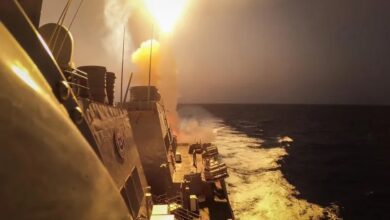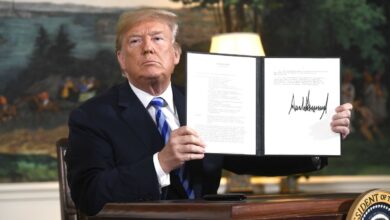
Iran stands today as a formidable drone power despite the strictures of a UN arms embargo and Donald Trump’s maximum pressure campaign. Iran has invested heavily in domestic drone manufacturing and benefitted from accessible technological advances in the commercial drone market. This has enabled the country to acquire an arsenal of unmanned aerial vehicle (UAV) systems which have wreaked havoc around the Middle East.
Iran has used drones to harass the US naval presence around the Persian Gulf, augment its influence in Syria and Iraq, and attack or threaten the critical infrastructure of US allies in the region.
To neutralize the Iranian drone threat, the US should pursue a strategy based on raising the costs of further attacks, investing in counter-drone technologies, and extending the UN arms embargo.
Iran’s UAV Program
Iran’s conventional air power has been rendered virtually obsolete due to financial impacts and procurement issues caused by sanctions. Investing in UAV technologies and production is therefore a strategic priority for regime leaders, giving Tehran an alternate means for long-range airstrikes.
Drones are particularly advantageous as they are cheaper to build and maintain than manned combat aircraft and can have longer flight endurance, greater maneuverability, and lower observability.
The dangers posed by Iran’s UAV program are amplified by Tehran sharing its advancements with its regional proxies, effectively gifting them with an instant air force. Iran-backed terrorist militias like Hezbollah and the Houthis boast the most active and sophisticated UAV programs among non-state actors, thanks to Iran’s success in smuggling drones and components to them as well as training them on their manufacture and operation.

The full extent of the Iranian drone threat became clear following the September 2019 attacks on the Abqaiq and Khurais oil facilities in Saudi Arabia, in which Tehran demonstrated the ability to execute complex, integrated drone swarm and missile attacks. Such tactics can potentially overwhelm even the most sophisticated air defenses, ensuring that the region’s most sensitive nuclear, energy, and transportation infrastructure are all vulnerable to attack.
It is only a matter of time before Iran shares this know-how with its proxies.
Three-Pronged Approach
To neutralize the Iranian drone threat, analysts at United Against Nuclear Iran (UANI) recommend the US pursue a strategy based on raising the costs of further attacks, investing in counter-drone technologies, and extending the UN arms embargo.
First, Washington and its allies must prioritize a strategy predicated on the deterrence of further attacks. For all of its regional adventurism, Iran is a risk-averse actor that seeks to avoid direct superpower confrontation. It frequently uses methods that provide plausible deniability, such as cyber or UAV attacks.
Iran’s greatest fear is a regime-destabilizing attack. Therefore, the US and its allies must make clear to Tehran that significant UAV attacks will be met with devastating reprisals, and that Iran will also be held accountable for such attacks by its proxies.
In addition to continuing the @UN arms embargo, the UN sanctions we are restoring on Iran will also re-impose accountability for other forms of Iranian malign activity that the authors of the nuclear deal foolishly downplayed. pic.twitter.com/VV9Rhkol40
— Secretary Pompeo (@SecPompeo) August 24, 2020
Second, Washington must invest and work with its allies to develop and deploy low-cost counter-drone solutions. Iran and its proxies have amassed arsenals of rockets, cruise and ballistic missiles, and UAVs, constituting a complex and increasingly precise aerial threat.
America and its allies require permanent, 360-degree multi-layered air and missile defenses to protect against the full scope of the Iranian threat, and must urgently prioritize boosting short-range air defenses at sensitive sites around the region.
The US should further seek to collaborate with Israel on cost-effective counter-drone innovations and ensure that as new technologies emerge, they are shared with other regional partners too.
Third, the US, France, and Britain must unite on the necessity of the UN Security Council renewing the arms embargo on Iran under Resolution 2231. If disunity or the concerted efforts of Russia and China – eager to sell Iran advanced weaponry – allow it to expire on October 18, Tehran will have a freer hand to acquire more powerful and deadly arms and to transfer such weaponry to its proxies without the Security Council’s approval.
Time to Act
In recent weeks, Iran’s regime has sought to cement long-term military and trade partnerships with Russia and China, offering discounts on oil prices in exchange for energy investment and access to weaponry, which includes potentially military-grade drones and components. This represents a significant proliferation threat for the region, underscoring the need to renew the embargo.
UAVs are an integral part of Iran’s efforts to expand its regional influence. The drone threat cannot be eliminated, but it can be contained by working collaboratively with allies to deter further attacks, develop counter-drone technologies, and keep a lid on Tehran’s ability to acquire increasingly lethal drones or provide them to its proxies.
The recent tragic explosion in Beirut highlights the dangers posed by vulnerable nuclear, oil, and chemical facilities around the region. It’s time for the international community to develop a strategy that ensures that Iran’s drones never light the fuse of a similar catastrophe.
 Jordan Steckler is a Research Analyst at United Against a Nuclear Iran. Previously, he served as a Senior Research Analyst at the American Israel Public Affairs Committee (AIPAC) from 2012-2017, where he focused primarily on Iran’s nuclear program and destabilizing regional activities. Mr. Steckler holds both an M.A. and B.A. in Middle Eastern Studies from George Washington University.
Jordan Steckler is a Research Analyst at United Against a Nuclear Iran. Previously, he served as a Senior Research Analyst at the American Israel Public Affairs Committee (AIPAC) from 2012-2017, where he focused primarily on Iran’s nuclear program and destabilizing regional activities. Mr. Steckler holds both an M.A. and B.A. in Middle Eastern Studies from George Washington University.
Disclaimer: The views and opinions expressed here are those of the author and do not necessarily reflect the editorial position of The Defense Post.
The Defense Post aims to publish a wide range of high-quality opinion and analysis from a diverse array of people – do you want to send us yours? Click here to submit an op-ed.











